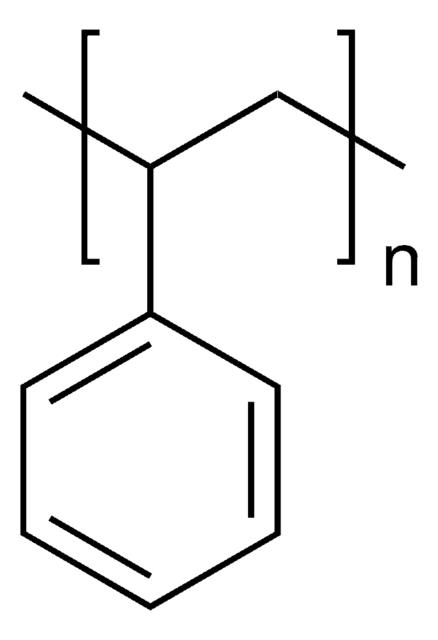430102
Polystyrene
average Mw ~192,000
Sinônimo(s):
PS
Faça loginpara ver os preços organizacionais e de contrato
About This Item
Fórmula linear:
[CH2CH(C6H5)]n
Número CAS:
Número MDL:
Código UNSPSC:
12162002
ID de substância PubChem:
NACRES:
NA.23
Produtos recomendados
forma
beads or pellets
índice de fusão
6.0-9.0 g/10 min (200°C/5kg)
peso molecular
average Mw ~192,000
índice de refração
n20/D 1.59
temperatura de transição
softening point 107 °C (Vicat, ASTM D 1525)
InChI
1S/C8H8/c1-2-8-6-4-3-5-7-8/h2-7H,1H2
chave InChI
PPBRXRYQALVLMV-UHFFFAOYSA-N
Procurando produtos similares? Visita Guia de comparação de produtos
Descrição geral
Hard, clear moderately strong polymer, biologically inert, good dimensional stability. Susceptible to exterior (UV) degradation.
Aplicação
Extrusion molded foamed packaging, dinnerware, bottles and toys. Injection molded packaging containers, toys and disposable cutlery.
forma física
Thermoplastic amorphous polymer.
Código de classe de armazenamento
11 - Combustible Solids
Classe de risco de água (WGK)
WGK 3
Ponto de fulgor (°F)
Not applicable
Ponto de fulgor (°C)
Not applicable
Equipamento de proteção individual
Eyeshields, Gloves, type N95 (US)
Escolha uma das versões mais recentes:
Já possui este produto?
Encontre a documentação dos produtos que você adquiriu recentemente na biblioteca de documentos.
Os clientes também visualizaram
Dharneedar Ravichandran et al.
Molecules (Basel, Switzerland), 24(22) (2019-11-17)
Polystyrene (PS) polymers have broad applications in protective packaging for food shipping, containers, lids, bottles, trays, tumblers, disposable cutlery and the making of models. Currently, most PS products, such as foams, are not accepted for recycling due to a low
Marta Kocun et al.
ACS nano, 11(10), 10097-10105 (2017-09-28)
Tapping mode atomic force microscopy (AFM), also known as amplitude modulated (AM) or AC mode, is a proven, reliable, and gentle imaging mode with widespread applications. Over the several decades that tapping mode has been in use, quantification of tip-sample
Hui Xia et al.
Journal of colloid and interface science, 376(1), 322-326 (2012-03-27)
The aggregation kinetics of particles in dense polystyrene latex suspensions is studied by low-coherence fiber optic dynamic light scattering. Low-coherence fiber optic dynamic light scattering is used to measure the hydrodynamic radius of the aggregates. The aggregation kinetics data obtained
Harikrishnan Narayanan Unni et al.
Electrophoresis, 30(5), 732-741 (2009-03-05)
This study reports a theoretical and experimental study on the irreversible deposition of colloidal particles from electrokinetic microfluidic flow. The electrokinetic particle transport model presented in this study is based on the stochastic Langevin equation, incorporating the electrical, hydrodynamic, Derjaguin-Landau-Verwey-Overbeek
Liang Zhang et al.
Journal of colloid and interface science, 353(2), 557-561 (2010-10-30)
Reported are adsorption isotherms for guar and hydroxypropyl guar (HPG), with and without the presence of borate ions, onto surfactant free anionic polystyrene latex. Guar and HPG formed adsorbed monolayers on the hydrophobic latex. The presence of borate ions converted
Nossa equipe de cientistas tem experiência em todas as áreas de pesquisa, incluindo Life Sciences, ciência de materiais, síntese química, cromatografia, química analítica e muitas outras.
Entre em contato com a assistência técnica




